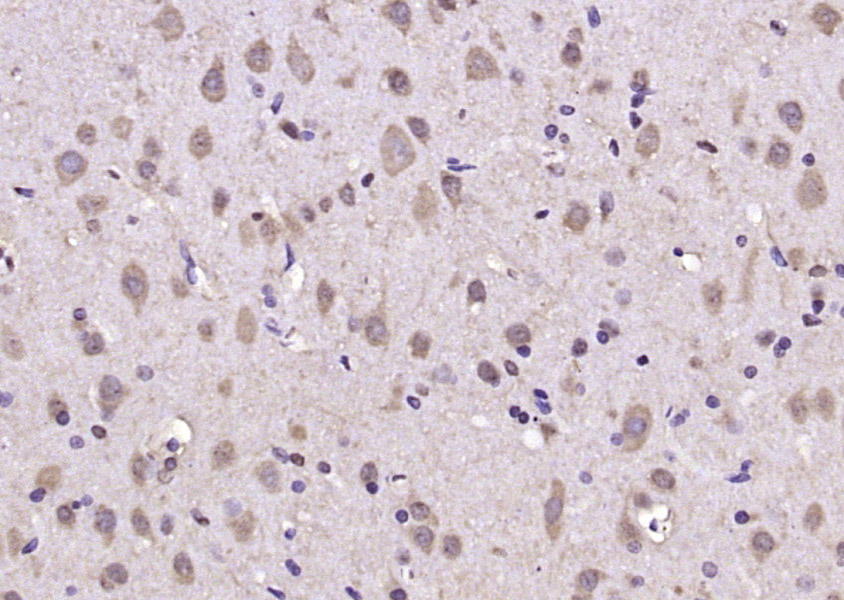
Rabbit Anti-PSME3 antibody
PA28G; 11S regulator complex gamma subunit; 11S regulator complex subunit gamma; Activator of multicatalytic protease subunit 3; Ki antibody Ki antigen; Ki nuclear autoantigen; Ki, PA28 gamma; PA28 gamma; PA28gamma; Proteasome (prosome, macropain) activat
View History [Clear]
Details
Product Name PSME3 Chinese Name 蛋白酶体激活因子PA28γ抗体 Alias PA28G; 11S regulator complex gamma subunit; 11S regulator complex subunit gamma; Activator of multicatalytic protease subunit 3; Ki antibody Ki antigen; Ki nuclear autoantigen; Ki, PA28 gamma; PA28 gamma; PA28gamma; Proteasome (prosome, macropain) activator subunit 3 (PA28 gamma; Ki); Proteasome (prosome, macropain) activator subunit 3; Proteasome activator 28 gamma; Proteasome activator 28 subunit gamma; Proteasome activator complex subunit 3; Proteasome activator subunit 3; PSME3; PSME3_HUMAN; Research Area Cell biology immunology Chromatin and nuclear signals Signal transduction Immunogen Species Rabbit Clonality Polyclonal React Species Rat, (predicted: Human, Mouse, Chicken, Dog, Pig, Cow, Horse, Rabbit, Sheep, ) Applications IHC-P=1:100-500 (Paraffin sections need antigen repair)
not yet tested in other applications.
optimal dilutions/concentrations should be determined by the end user.Theoretical molecular weight 28kDa Cellular localization The nucleus Form Liquid Concentration 1mg/ml immunogen KLH conjugated synthetic peptide derived from human PSME3: 2-100/254 Lsotype IgG Purification affinity purified by Protein A Buffer Solution 0.01M TBS(pH7.4) with 1% BSA, 0.03% Proclin300 and 50% Glycerol. Storage Shipped at 4℃. Store at -20 °C for one year. Avoid repeated freeze/thaw cycles. Attention This product as supplied is intended for research use only, not for use in human, therapeutic or diagnostic applications. PubMed PubMed Product Detail The 26S proteasome is a multicatalytic proteinase complex with a highly ordered structure composed of 2 complexes, a 20S core and a 19S regulator. The 20S core is composed of 4 rings of 28 non-identical subunits; 2 rings are composed of 7 alpha subunits and 2 rings are composed of 7 beta subunits. The 19S regulator is composed of a base, which contains 6 ATPase subunits and 2 non-ATPase subunits, and a lid, which contains up to 10 non-ATPase subunits. Proteasomes are distributed throughout eukaryotic cells at a high concentration and cleave peptides in an ATP/ubiquitin-dependent process in a non-lysosomal pathway. An essential function of a modified proteasome, the immunoproteasome, is the processing of class I MHC peptides. The immunoproteasome contains an alternate regulator, referred to as the 11S regulator or PA28, that replaces the 19S regulator. Three subunits (alpha, beta and gamma) of the 11S regulator have been identified. This gene encodes the gamma subunit of the 11S regulator. Six gamma subunits combine to form a homohexameric ring. Alternate splicing results in multiple transcript variants. [provided by RefSeq, May 2012]
Function:
Subunit of the 11S REG-gamma (also called PA28-gamma) proteasome regulator, a doughnut-shaped homoheptamer which associates with the proteasome. 11S REG-gamma activates the trypsin-like catalytic subunit of the proteasome but inhibits the chymotrypsin-like and postglutamyl-preferring (PGPH) subunits. Facilitates the MDM2-p53/TP53 interaction which promotes ubiquitination- and MDM2-dependent proteasomal degradation of p53/TP53, limiting its accumulation and resulting in inhibited apoptosis after DNA damage. May also be involved in cell cycle regulation. Mediates CCAR2 and CHEK2-dependent SIRT1 inhibition (PubMed:25361978).
Subunit:
Homoheptamer; the stability of the heptamer is essential for the specific activation of the trypsine-like subunit and inhibition of the chymotrypsin-like and postglutamyl-preferring (PGPH) subunits of the proteasome. Interacts with p53/TP53 and MDM2. Interacts with MAP3K3 (By similarity). Associates with the proteasome. Interacts with CCAR2. Interacts with FAM192A (via C-terminus); the interaction is direct and promotes the association of PSME3 with the 20S proteasome (PubMed:29934401). Interacts with COIL; the interaction is inhibited by FAM192A (PubMed:29934401).
Subcellular Location:
Nucleus
SWISS:
P61289
Gene ID:
10197
Database links:Entrez Gene: 10197 Human
Entrez Gene: 19192 Mouse
Omim: 605129 Human
SwissProt: Q5F3J5 Chicken
SwissProt: P61289 Human
SwissProt: P61290 Mouse
Unigene: 152978 Human
Unigene: 288477 Mouse
Unigene: 198325 Rat
Product Picture
References (0)
No References
Bought notes(bought amounts latest0)
No one bought this product
User Comment(Total0User Comment Num)
- No comment



 +86 571 56623320
+86 571 56623320
 +86 18668110335
+86 18668110335

